Core–Shell Structured Silica-Coated Iron Nanowires Composites for Enhanced Electromagnetic Wave Absorption Properties
Abstract
1. Introduction
2. Results and Discussion
3. Materials and Methods
3.1. Materials
3.2. Synthesis
3.3. Characterization
4. Conclusions
Author Contributions
Funding
Institutional Review Board Statement
Informed Consent Statement
Data Availability Statement
Conflicts of Interest
Appendix A



References
- Wang, B.; Wu, Q.; Fu, Y.; Liu, T. A Review on Carbon/Magnetic Metal Composites for Microwave Absorption. J. Mater. Sci. Technol. 2021, 86, 91–109. [Google Scholar] [CrossRef]
- Guo, R.; Su, D.; Chen, F.; Cheng, Y.; Wang, X.; Gong, R.; Luo, H. Hollow Beaded Fe3C/N-Doped Carbon Fibers toward Broadband Microwave Absorption. ACS Appl. Mater. Interfaces 2022, 14, 3084–3094. [Google Scholar] [CrossRef]
- Zhu, X.; Qiu, H.; Chen, P.; Chen, G.; Min, W. Graphitic Carbon Nitride (g-C3N4) in Situ Polymerization to Synthesize MOF-Co@CNTs as Efficient Electromagnetic Microwave Absorption Materials. Carbon 2021, 176, 530–539. [Google Scholar] [CrossRef]
- Wang, F.; Gu, W.; Chen, J.; Huang, Q.; Han, M.; Wang, G.; Ji, G. Improved Electromagnetic Dissipation of Fe Doping LaCoO3 toward Broadband Microwave Absorption. J. Mater. Sci. Technol. 2022, 105, 92–100. [Google Scholar] [CrossRef]
- Liu, D.; Yang, L.; Wang, F.; Zhang, H.; Liu, J.; Lv, T.; Zhao, H.; Du, Y. Hierarchical Carbon Nanotubes@Ni/C Foams for High-Performance Microwave Absorption. Carbon 2022, 196, 867–876. [Google Scholar] [CrossRef]
- Cheng, R.; Wang, Y.; Di, X.; Lu, Z.; Wang, P.; Wu, X. Heterostructure Design of MOFs Derived Co9S8/FeCoS2/C Composite with Efficient Microwave Absorption and Waterproof Functions. J. Mater. Sci. Technol. 2022, 129, 15–26. [Google Scholar] [CrossRef]
- Shen, Z.; Chen, J.; Li, B.; Li, G.; Zhang, Z.; Hou, X. Recent Progress in SiC Nanowires as Electromagnetic Microwaves Absorbing Materials. J. Alloys Compd. 2020, 815, 152388. [Google Scholar] [CrossRef]
- Wang, N.; Wang, Y.; Lu, Z.; Cheng, R.; Yang, L.; Li, Y. Hierarchical Core-Shell FeS2/Fe7S8@C Microspheres Embedded into Interconnected Graphene Framework for High-Efficiency Microwave Attenuation. Carbon 2023, 202, 254–264. [Google Scholar] [CrossRef]
- Wang, W.; Wang, Y.; Lu, Z.; Cheng, R.; Zheng, H. Hollow ZnO/ZnFe2O4 Microspheres Anchored Graphene Aerogels as a High-Efficiency Microwave Absorber with Thermal Insulation and Hydrophobic Performances. Carbon 2023, 203, 397–409. [Google Scholar] [CrossRef]
- Lu, Y.; Yang, P.; Li, Y.; Wen, D.; Luo, J.; Wang, S.; Wu, F.; Fang, L.; Pang, Y. A Facile Synthesis of NiFe-Layered Double Hydroxide and Mixed Metal Oxide with Excellent Microwave Absorption Properties. Molecules 2021, 26, 5046. [Google Scholar] [CrossRef]
- Wang, K.; Chu, W.; Li, H.; Chen, Y.; Cai, Y.; Liu, H. Ferromagnetic Ti3CNCl2-Decorated RGO Aerogel: From 3D Interconnecting Conductive Network Construction to Ultra-Broadband Microwave Absorber with Thermal Insulation Property. J. Colloid. Interface Sci. 2021, 604, 402–414. [Google Scholar] [CrossRef]
- Zhang, C.; Liu, Z.; Xu, P.; Zhang, Y.; Yue, X. Porous Carbon/Graphite Nanosheet/Ferromagnetic Nanoparticle Composite Absorbents with Adjustable Electromagnetic Properties. Nanotechnology 2021, 32, 205707. [Google Scholar] [CrossRef] [PubMed]
- Zheng, W.; Ye, W.; Yang, P.; Wang, D.; Xiong, Y.; Liu, Z.; Qi, J.; Zhang, Y. Recent Progress in Iron-Based Microwave Absorbing Composites: A Review and Prospective. Molecules 2022, 27, 4117. [Google Scholar] [CrossRef]
- Zhou, Y.; Ma, L.; Li, R.; Chen, D.; Lu, Y.; Cheng, Y.; Luo, X.; Xie, H.; Zhou, W. Enhanced Heat-Resistance Property of Aluminum-Coated Carbonyl Iron Particles as Microwave Absorption Materials. J. Magn. Magn. Mater. 2021, 524, 167681. [Google Scholar] [CrossRef]
- Shorstkii, I.A.; Yakovlev, N. Method of Absorbing Material Formation Based on Magnetically Controlled Particles of Fe3O4. Inorg. Mater. Appl. Res. 2020, 11, 1236–1243. [Google Scholar] [CrossRef]
- Chen, N.; Jiang, J.-T.; Xu, C.-Y.; Yuan, Y.; Gong, Y.-X.; Zhen, L. Co7Fe3 and Co7Fe3@SiO2 Nanospheres with Tunable Diameters for High-Performance Electromagnetic Wave Absorption. ACS Appl. Mater. Interfaces 2017, 9, 21933–21941. [Google Scholar] [CrossRef] [PubMed]
- Ge, C.; Wang, L.; Liu, G.; Wang, T.; Chen, H. Effects of Particle Size on Electromagnetic Properties of Spherical Carbonyl Iron. J. Mater. Sci. Mater. Electron. 2019, 30, 8390–8398. [Google Scholar] [CrossRef]
- Tong, G.-X.; Wu, W.-H.; Hu, Q.; Yuan, J.-H.; Qiao, R.; Qian, H.-S. Enhanced Electromagnetic Characteristics of Porous Iron Particles Made by a Facile Corrosion Technique. Mater. Chem. Phys. 2012, 132, 563–569. [Google Scholar] [CrossRef]
- Gao, S.; Zhang, Y.; He, J.; Zhang, X.; Jiao, F.; Liu, T.; Li, H.; Wu, C.; Ma, M. Coal Gasification Fine Slag Residual Carbon Decorated with Hollow-Spherical Fe3O4 Nanoparticles for Microwave Absorption. Ceram. Int. 2023, 49, 17554–17565. [Google Scholar] [CrossRef]
- Tong, G.; Ma, J.; Wu, W.; Hua, Q.; Qiao, R.; Qian, H. Grinding Speed Dependence of Microstructure, Conductivity, and Microwave Electromagnetic and Absorbing Characteristics of the Flaked Fe Particles. J. Mater. Res. 2011, 26, 682–688. [Google Scholar] [CrossRef]
- Ji, P.; Xie, G.; Xie, N.; Li, J.; Chen, J.; Chen, J. Microwave Absorbing Properties of Flaky Carbonyl Iron Powder Prepared by Rod Milling Method. J. Electron. Mater. 2019, 48, 2495–2500. [Google Scholar] [CrossRef]
- Wei, H.; Zhang, Z.; Zhou, L.; Heidarshenas, B.; Zhang, C.; Xia, J.; Zhi, L.; Shen, G.; Wu, H. Influence of Heat Treatment on the Microwave Absorption Properties of Flaky Carbonyl Iron Powder. Int. J. Lightweight Mater. Manuf. 2020, 3, 258–264. [Google Scholar] [CrossRef]
- Shen, J.; Yao, Y.; Liu, Y.; Leng, J. Tunable Hierarchical Fe Nanowires with a Facile Template-Free Approach for Enhanced Microwave Absorption Performance. J. Mater. Chem. C 2016, 4, 7614–7621. [Google Scholar] [CrossRef]
- Li, R.; Li, X.; Yang, P.-A.; Ruan, H. High-Aspect-Ratio Iron Nanowires: Magnetic Field-Assisted in Situ Reduction Synthesis and Extensive Parametric Study. Nanotechnology 2020, 31, 145601. [Google Scholar] [CrossRef] [PubMed]
- Li, X.; Guo, X.; Liu, T.; Zheng, X.; Bai, J. Shape-Controlled Synthesis of Fe Nanostructures and Their Enhanced Microwave Absorption Properties at L-Band. Mater. Res. Bull. 2014, 59, 137–141. [Google Scholar] [CrossRef]
- Yang, P.; Ruan, H.; Sun, Y.; Li, R.; Lu, Y.; Xiang, C. Excellent Microwave Absorption Performances of High Length-Diameter Ratio Iron Nanowires with Low Filling Ratio. Nanotechnology 2020, 31, 395708. [Google Scholar] [CrossRef]
- Zhao, Z.; Jia, Z.; Wu, H.; Gao, Z.; Zhang, Y.; Kou, K.; Huang, Z.; Feng, A.; Wu, G. Morphology-Dependent Electromagnetic Wave Absorbing Properties of Iron-Based Absorbers: One-Dimensional, Two-Dimensional, and Three-Dimensional Classification. Eur. Phys. J. Appl. Phys. 2019, 87, 20901. [Google Scholar] [CrossRef]
- Yang, B.; Fang, J.; Xu, C.; Cao, H.; Zhang, R.; Zhao, B.; Huang, M.; Wang, X.; Lv, H.; Che, R. One-Dimensional Magnetic FeCoNi Alloy Toward Low-Frequency Electromagnetic Wave Absorption. Nano-Micro Lett. 2022, 14, 170. [Google Scholar] [CrossRef]
- Li, D.; Liao, H.; Kikuchi, H.; Liu, T. Microporous Co@C Nanoparticles Prepared by Dealloying CoAl@C Precursors: Achieving Strong Wideband Microwave Absorption via Controlling Carbon Shell Thickness. ACS Appl. Mater. Interfaces 2017, 9, 44704–44714. [Google Scholar] [CrossRef]
- Huang, B.; Yue, J.; Wei, Y.; Huang, X.; Tang, X.; Du, Z. Enhanced Microwave Absorption Properties of Carbon Nanofibers Functionalized by FeCo Coatings. Appl. Surf. Sci. 2019, 483, 98–105. [Google Scholar] [CrossRef]
- Liao, H.; Li, D.; Zhou, C.; Liu, T. Microporous Co/RGO Nanocomposites: Strong and Broadband Microwave Absorber with Well-Matched Dielectric and Magnetic Loss. J. Alloy. Compd. 2019, 782, 556–565. [Google Scholar] [CrossRef]
- Liu, P.; Gao, S.; Wang, Y.; Zhou, F.; Huang, Y.; Huang, W.; Chang, N. Core-Shell Ni@C Encapsulated by N-Doped Carbon Derived from Nickel-Organic Polymer Coordination Composites with Enhanced Microwave Absorption. Carbon 2020, 170, 503–516. [Google Scholar] [CrossRef]
- Wang, T.; Wang, H.; Chi, X.; Li, R.; Wang, J. Synthesis and Microwave Absorption Properties of Fe–C Nanofibers by Electrospinning with Disperse Fe Nanoparticles Parceled by Carbon. Carbon 2014, 74, 312–318. [Google Scholar] [CrossRef]
- Yang, P.-A.; Huang, Y.; Li, R.; Huang, X.; Ruan, H.; Shou, M.; Li, W.; Zhang, Y.; Li, N.; Dong, L. Optimization of Fe@Ag Core–Shell Nanowires with Improved Impedance Matching and Microwave Absorption Properties. Chem. Eng. J. 2022, 430, 132878. [Google Scholar] [CrossRef]
- Liu, X.; Chen, Y.; Cui, X.; Zeng, M.; Yu, R.; Wang, G.-S. Flexible Nanocomposites with Enhanced Microwave Absorption Properties Based on Fe3O4/SiO2 Nanorods and Polyvinylidene Fluoride. J. Mater. Chem. A 2015, 3, 12197–12204. [Google Scholar] [CrossRef]
- Feng, J.; Hou, Y.; Wang, Y.; Li, L. Synthesis of Hierarchical ZnFe2O4@SiO2@RGO Core–Shell Microspheres for Enhanced Electromagnetic Wave Absorption. ACS Appl. Mater. Interfaces 2017, 9, 14103–14111. [Google Scholar] [CrossRef]
- Wang, B.; Liao, H.; Xie, X.; Wu, Q.; Liu, T. Bead-like Cobalt Nanoparticles Coated with Dielectric SiO2 and Carbon Shells for High-Performance Microwave Absorber. J. Colloid. Interface Sci. 2020, 578, 346–357. [Google Scholar] [CrossRef]
- Piao, M.; Li, C.; Zhang, Y.; Yi, Q.; Zhang, H.; Wang, X.; Zhang, F. High Efficiency Fabrication of Co Nanosheets Deposited by SiO2 Layer with Controllable Permittivity toward Superior Electromagnetic Wave Absorption. J. Alloys Compd. 2022, 928, 167230. [Google Scholar] [CrossRef]
- Qu, Z.; Wang, Y.; Yang, P.; Zheng, W.; Li, N.; Bai, J.; Zhang, Y.; Li, K.; Wang, D.; Liu, Z.; et al. Enhanced Electromagnetic Wave Absorption Properties of Ultrathin MnO2 Nanosheet-Decorated Spherical Flower-Shaped Carbonyl Iron Powder. Molecules 2022, 27, 135. [Google Scholar] [CrossRef]
- Liu, S.; Yu, M.; Zheng, Q.; Liang, X.; Xie, S.; Xu, Y.; Wang, C. Optimized Impedance Matching and Enhanced Microwave Absorbing Performance of Porous Flaky Fe4N Wrapped with SiO2. J. Magn. Magn. Mater. 2021, 536, 168119. [Google Scholar] [CrossRef]
- Amiri, S.; Shokrollahi, H. Magnetic and Structural Properties of RE Doped Co-Ferrite (REåNd, Eu, and Gd) Nano-Particles Synthesized by Co-Precipitation. J. Magn. Magn. Mater. 2013, 345, 18–23. [Google Scholar] [CrossRef]
- Xie, X.; Ni, C.; Lin, Z.; Wu, D.; Sun, X.; Zhang, Y.; Wang, B.; Du, W. Phase and Morphology Evolution of High Dielectric CoO/Co3O4 Particles with Co3O4 Nanoneedles on Surface for Excellent Microwave Absorption Application. Chem. Eng. J. 2020, 396, 125205. [Google Scholar] [CrossRef]
- Liu, Y.; Tai, R.; Drew, M.G.B.; Liu, Y. Several Theoretical Perspectives of Ferrite-Based Materials—Part 1: Transmission Line Theory and Microwave Absorption. J. Supercond. Nov. Magn. 2017, 30, 2489–2504. [Google Scholar] [CrossRef]
- Wang, F.; Li, X.; Chen, Z.; Yu, W.; Loh, K.P.; Zhong, B.; Shi, Y.; Xu, Q.-H. Efficient Low-Frequency Microwave Absorption and Solar Evaporation Properties of γ-Fe2O3 Nanocubes/Graphene Composites. Chem. Eng. J. 2021, 405, 126676. [Google Scholar] [CrossRef]
- Ma, G.; Sun, J.; Aslani, F.; Huang, Y.; Jiao, F. Review on Electromagnetic Wave Absorbing Capacity Improvement of Cementitious Material. Constr. Build. Mater. 2020, 262, 120907. [Google Scholar] [CrossRef]
- Huang, Z.D.; Ma, R.; Zhou, J.; Wang, L.; Xie, Q. Investigation on Microstructures, Electronic Structures, Electromagnetic Properties and Microwave Absorption Properties of Fe3Si/PPy Composites. J. Alloys Compd. 2021, 873, 159779. [Google Scholar] [CrossRef]
- Sun, M.; Xiong, Z.; Zhang, Z.; Chen, C.; Qin, L.; Wang, D.; Wu, F.; Liu, P. One-Dimensional Ag@NC-Co@NC Composites with Multiphase Core-Shell Hetero-Interfaces for Boosting Microwave Absorption. Compos. Sci. Technol. 2022, 228, 109663. [Google Scholar] [CrossRef]
- Qin, M.; Zhang, L.; Wu, H. Dielectric Loss Mechanism in Electromagnetic Wave Absorbing Materials. Adv. Sci. 2022, 9, 2105553. [Google Scholar] [CrossRef] [PubMed]
- Jiang, Z.; Si, H.; Chen, X.; Liu, H.; Zhang, L.; Zhang, Y.; Gong, C.; Zhang, J. Simultaneous Enhancement of Impedance Matching and the Absorption Behavior of BN/RGO Nanocomposites for Efficiency Microwave Absorption. Compos. Commun. 2020, 22, 100503. [Google Scholar] [CrossRef]
- Yin, P.; Deng, Y.; Zhang, L.; Li, N.; Feng, X.; Wang, J.; Zhang, Y. Facile Synthesis and Microwave Absorption Investigation of Activated Carbon@Fe3O4 Composites in the Low Frequency Band. RSC Adv. 2018, 8, 23048–23057. [Google Scholar] [CrossRef]
- Lu, Y.; You, W.; Cai, C.; Yu, X.; Zhao, Y.; Liu, X.; Guo, J.; Zhang, X.; Zeng, W.; Che, R. Insights into the Micro Magnetic Loss Mechanism of Microwave Absorption by Off-Axis Electron Holography. J. Magn. Magn. Mater. 2019, 475, 24–29. [Google Scholar] [CrossRef]
- Cao, Y.; Liu, C.; Xue, Z.; Jiang, T.; Fang, G.; Peng, K.; Zhang, Y. Excellent Microwave Absorption of Fe3O4/Ag Composites Attained by Synergy of Considerable Magnetic Loss and Dielectric Loss. Ceram. Int. 2022, 48, 5824–5830. [Google Scholar] [CrossRef]
- Zhou, X.; Zhou, K.; Zhang, T.; Fan, L.; Zhang, H.; Zheng, H. Static Magnetic, Complex Dielectric and Complex Permeability Properties of Aluminum Substituted Hexagonal Barium Ferrites Based on Doping Concentration. J. Ceram. Soc. Jpn. 2021, 129, 566–573. [Google Scholar] [CrossRef]
- Pan, J.; Guo, H.; Wang, M.; Yang, H.; Hu, H.; Liu, P.; Zhu, H. Shape Anisotropic Fe3O4 Nanotubes for Efficient Microwave Absorption. Nano Res. 2020, 13, 621–629. [Google Scholar] [CrossRef]
- Zhao, B.; Li, Y.; Ji, H.; Bai, P.; Wang, S.; Fan, B.; Guo, X.; Zhang, R. Lightweight Graphene Aerogels by Decoration of 1D CoNi Chains and CNTs to Achieve Ultra-Wide Microwave Absorption. Carbon 2021, 176, 411–420. [Google Scholar] [CrossRef]
- Ma, L.; Li, S.; Liu, F.; Ma, S.; Han, E.-H.; Zhang, Z. Metal-Organic Framework-Derived Co/C Composite with High Magnetization as Broadband Electromagnetic Wave Absorber. J. Alloys Compd. 2022, 906, 164257. [Google Scholar] [CrossRef]
- Fang, G.; Liu, C.; Xu, G.; Xiao, A.; Peng, K.; Zhang, Y.; Zhang, Y. Enhanced Microwave Absorption Properties of Zr4+-Doped Fe3O4 for Coordinated Impedance Matching and Attenuation Performances. J. Alloys Compd. 2019, 790, 316–325. [Google Scholar] [CrossRef]
- Li, Y.; Sun, N.; Liu, J.; Hao, X.; Du, J.; Yang, H.; Li, X.; Cao, M. Multifunctional BiFeO3 Composites: Absorption Attenuation Dominated Effective Electromagnetic Interference Shielding and Electromagnetic Absorption Induced by Multiple Dielectric and Magnetic Relaxations. Compos. Sci. Technol. 2018, 159, 240–250. [Google Scholar] [CrossRef]
- Sun, X.; Li, Y.; Huang, Y.; Cheng, Y.; Wang, S.; Yin, W. Achieving Super Broadband Electromagnetic Absorption by Optimizing Impedance Match of RGO Sponge Metamaterials. Adv. Funct. Mater. 2022, 32, 2107508. [Google Scholar] [CrossRef]
- Xiang, J.; Li, J.; Zhang, X.; Ye, Q.; Xu, J.; Shen, X. Magnetic Carbon Nanofibers Containing Uniformly Dispersed Fe/Co/Ni Nanoparticles as Stable and High-Performance Electromagnetic Wave Absorbers. J. Mater. Chem. A 2014, 2, 16905–16914. [Google Scholar] [CrossRef]
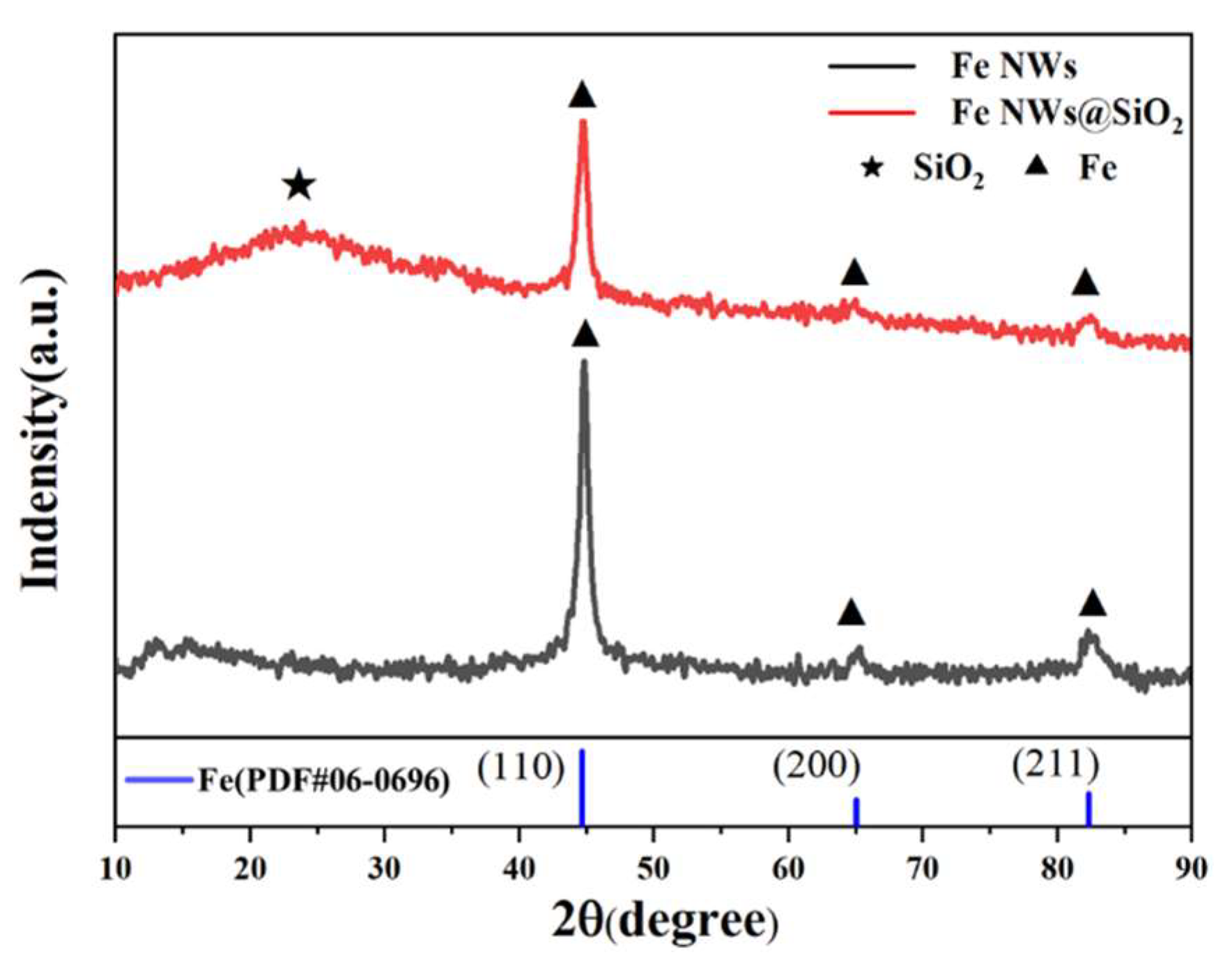
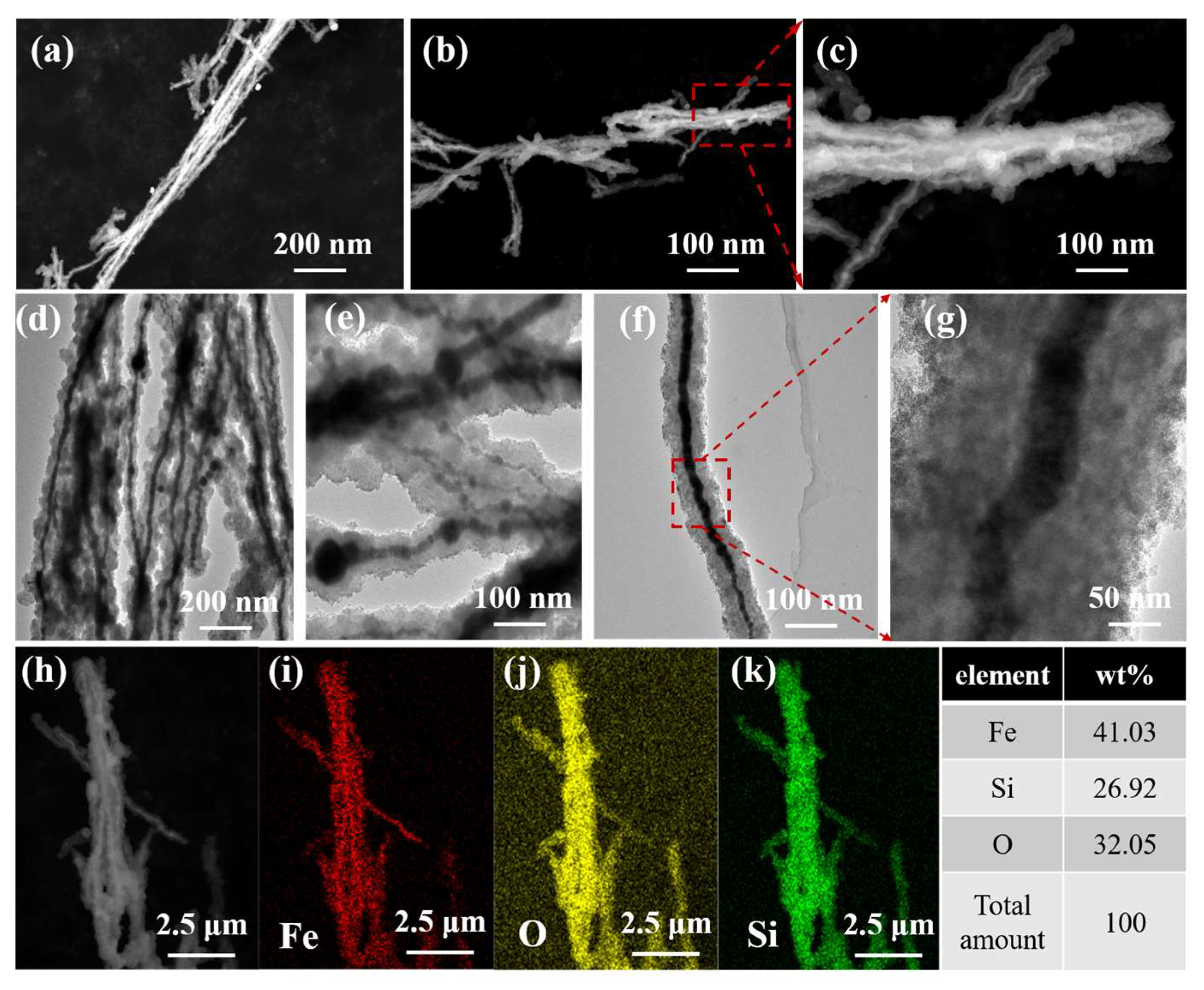
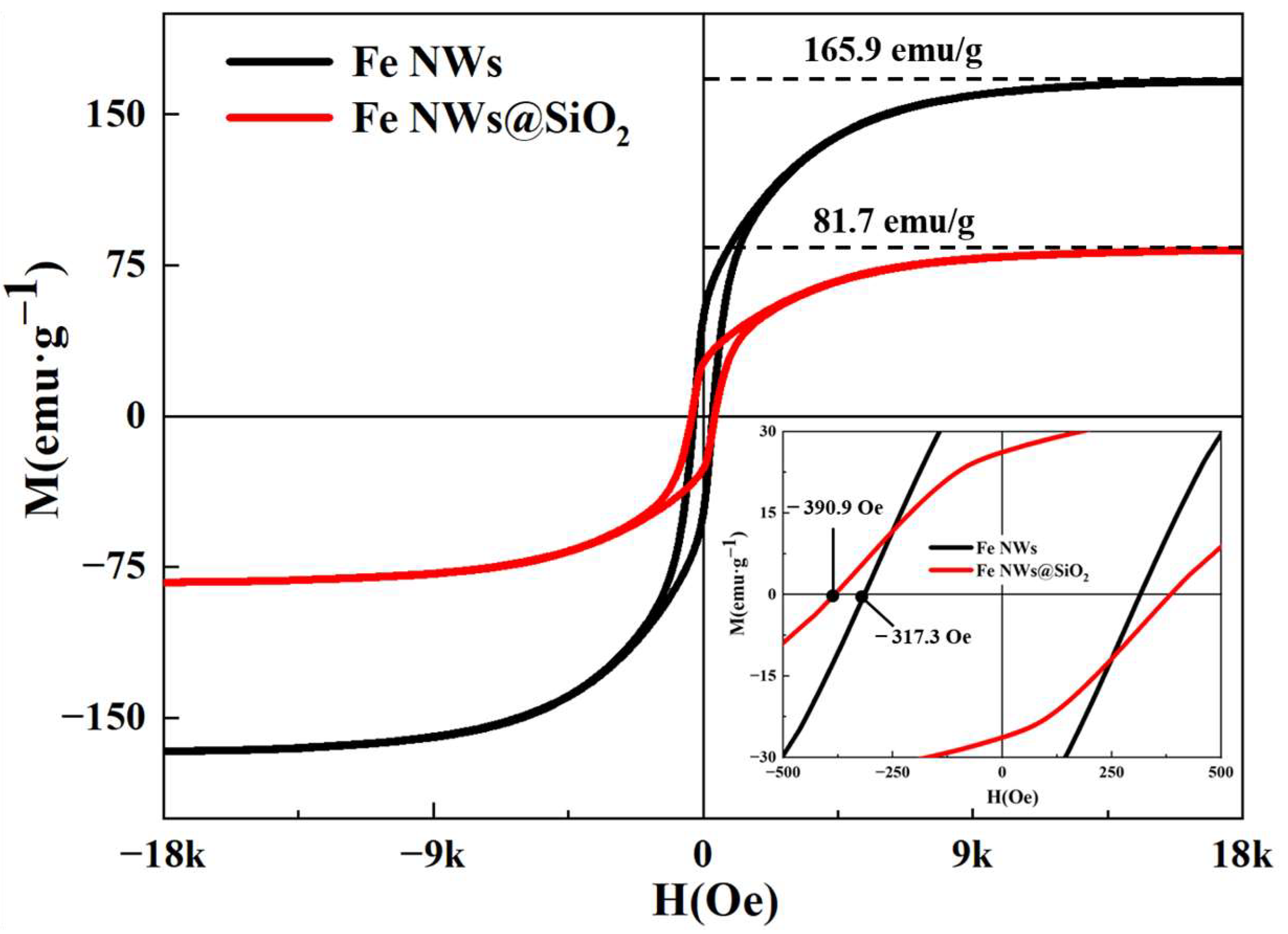
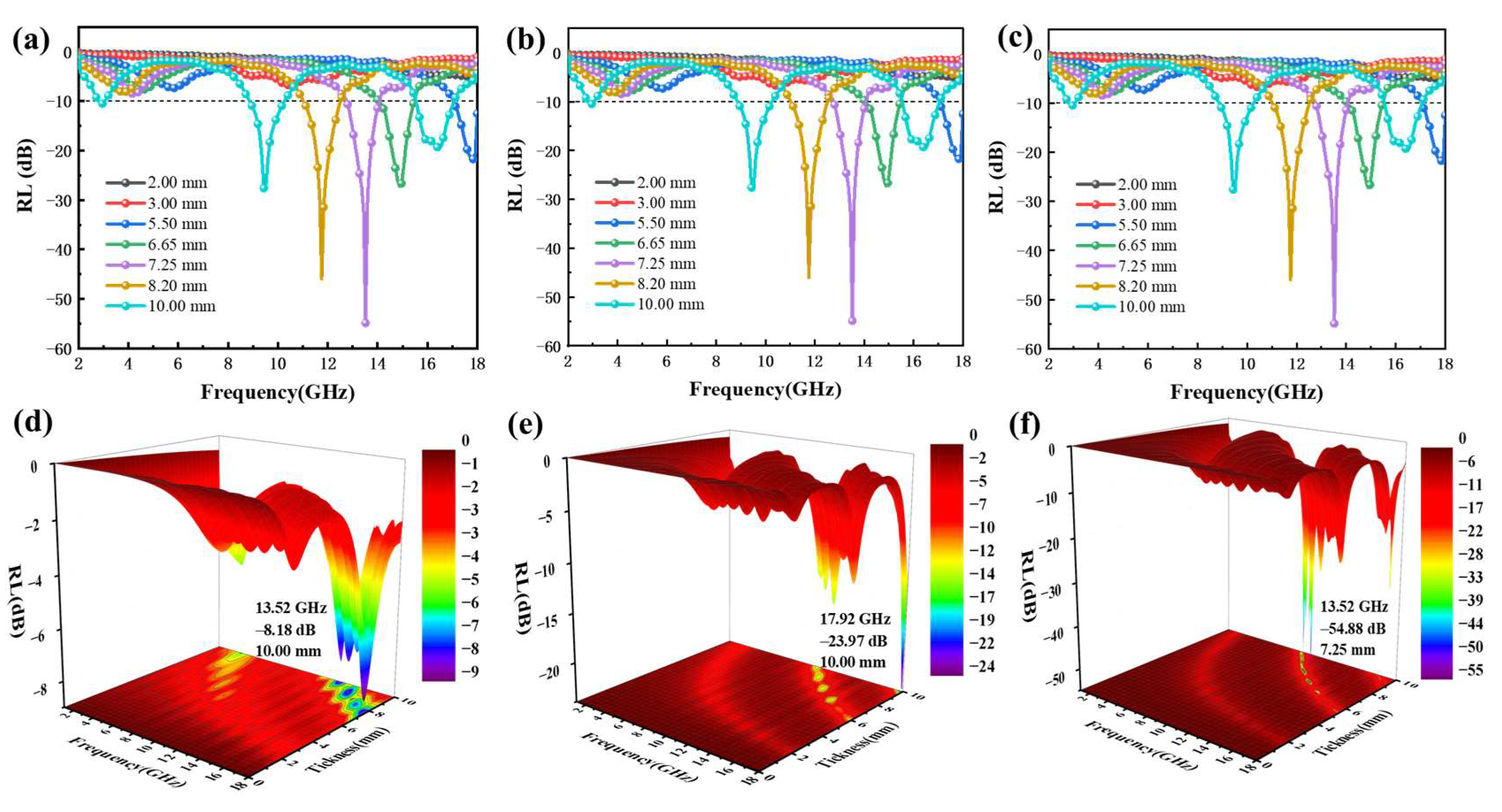


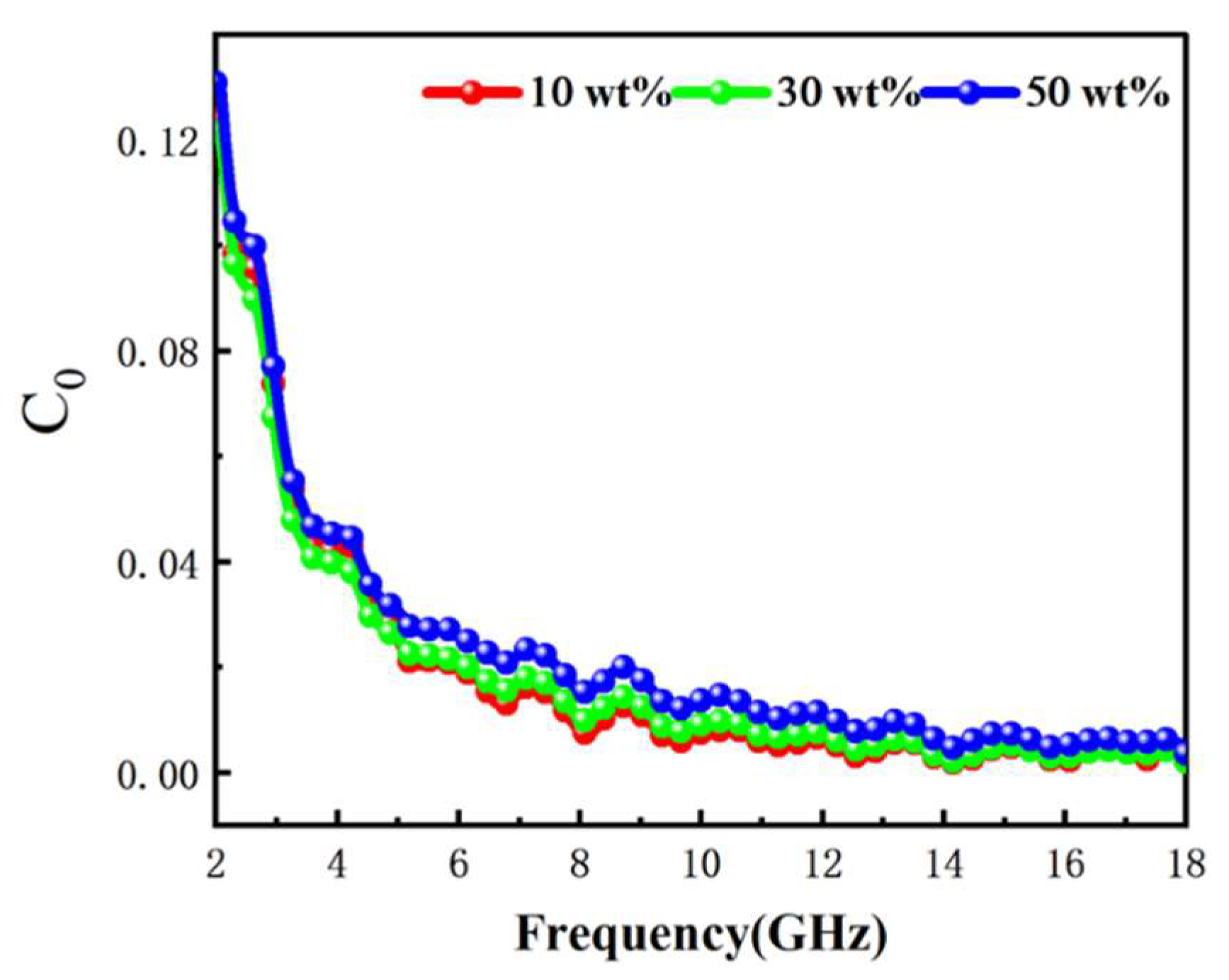
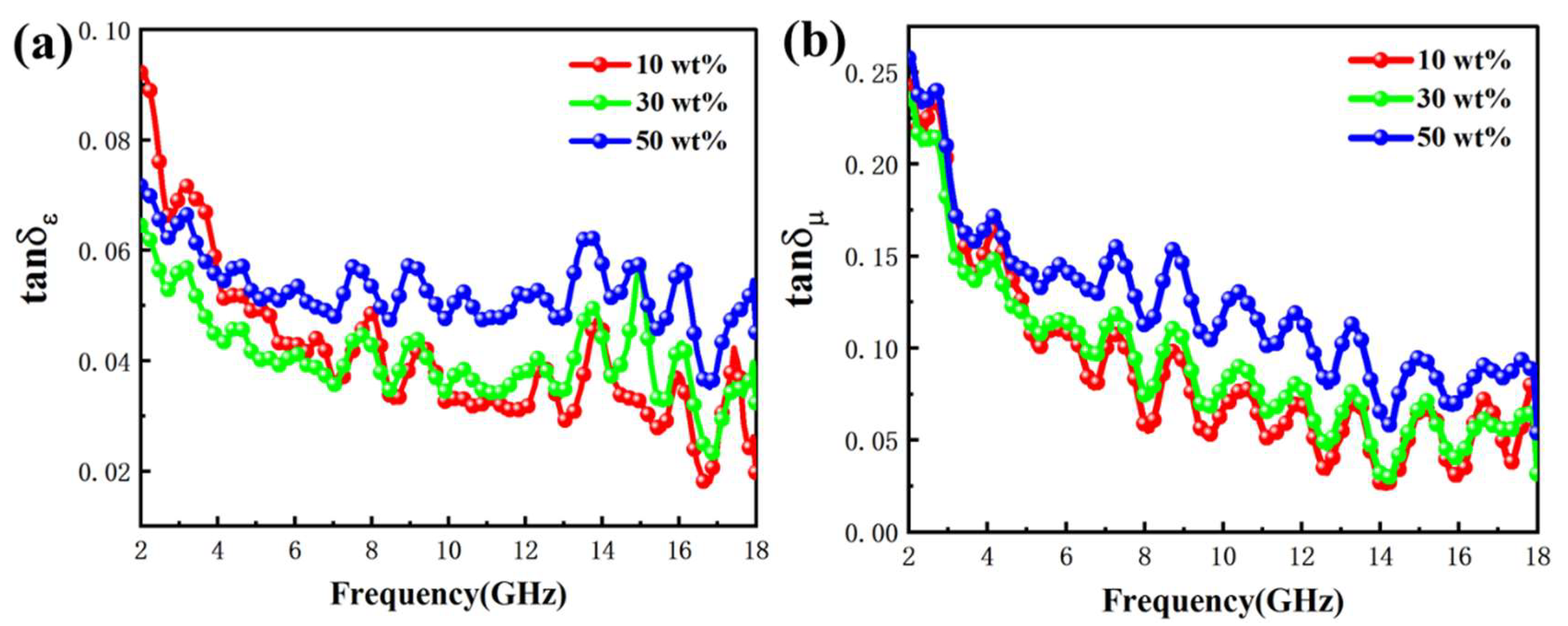
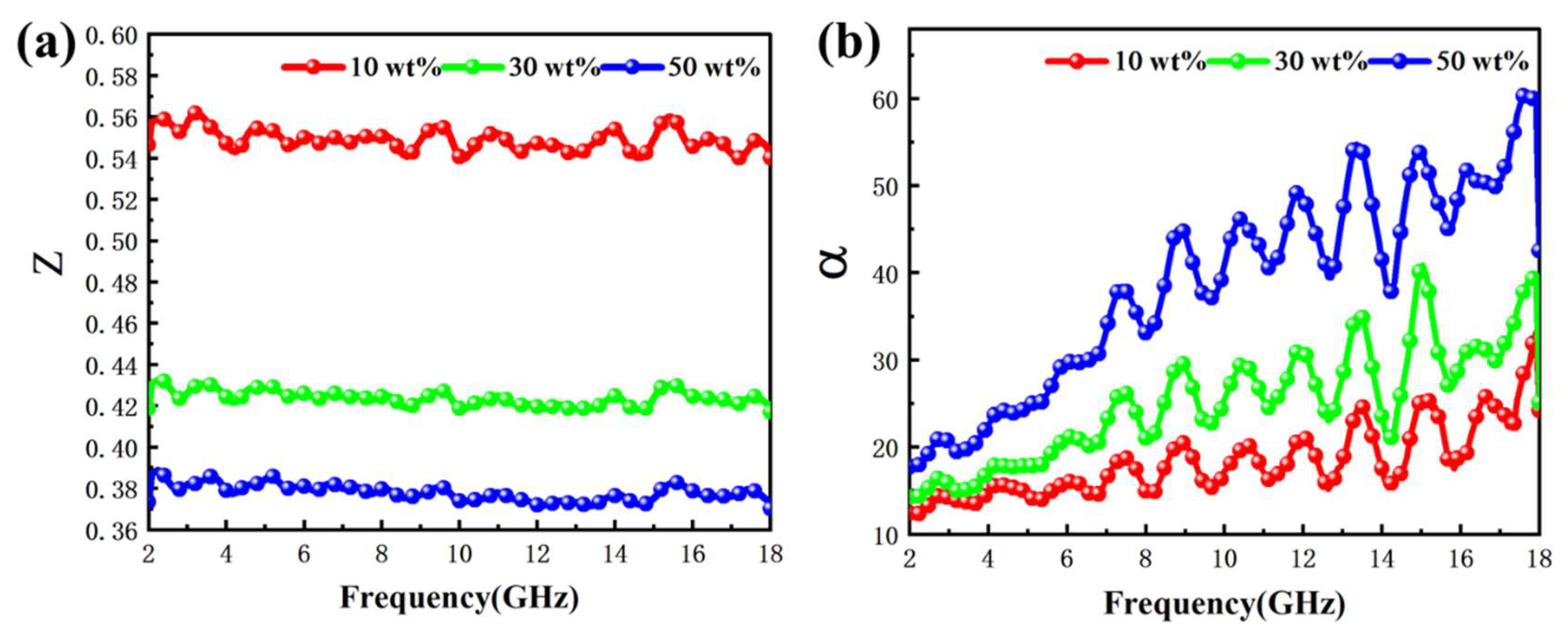
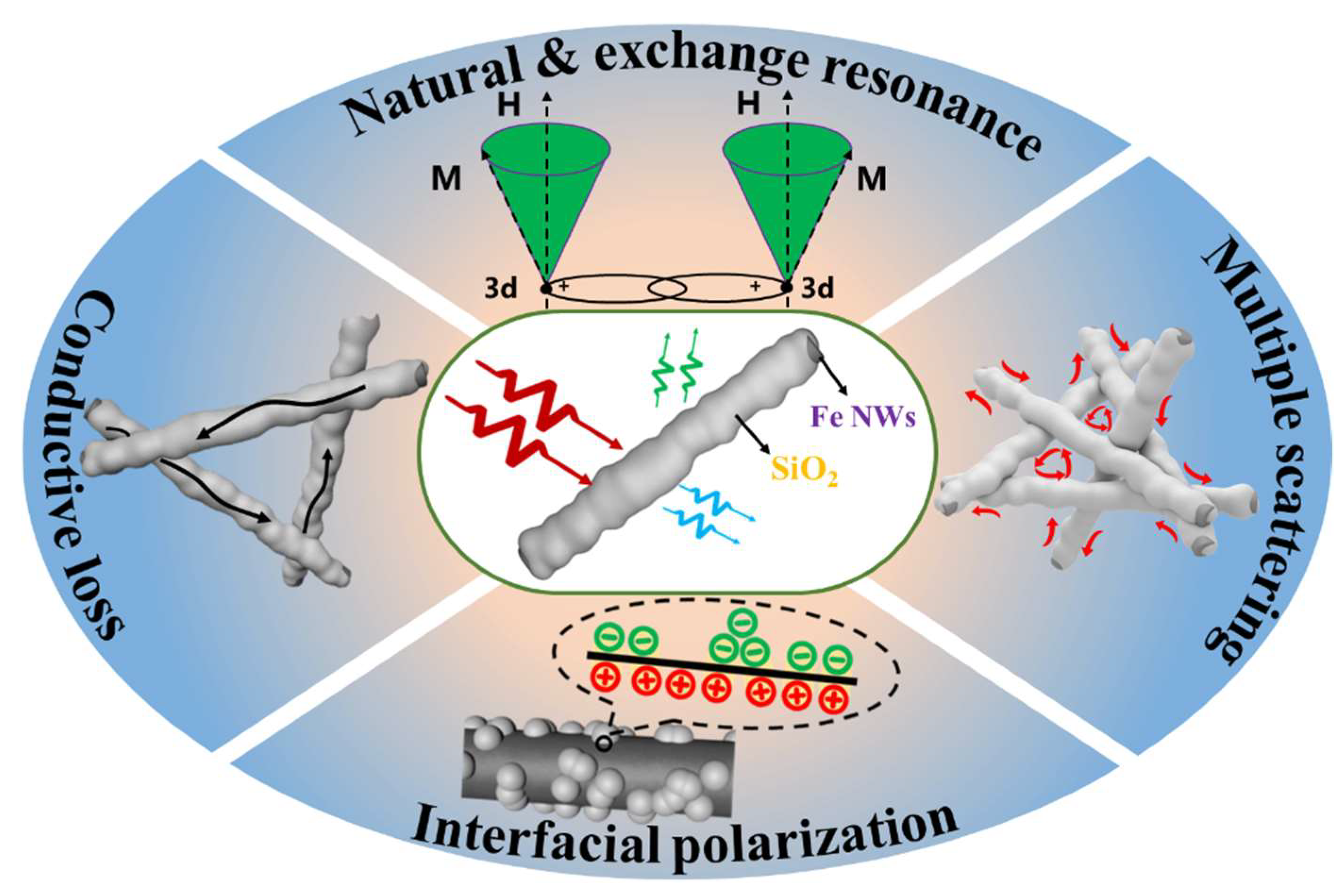
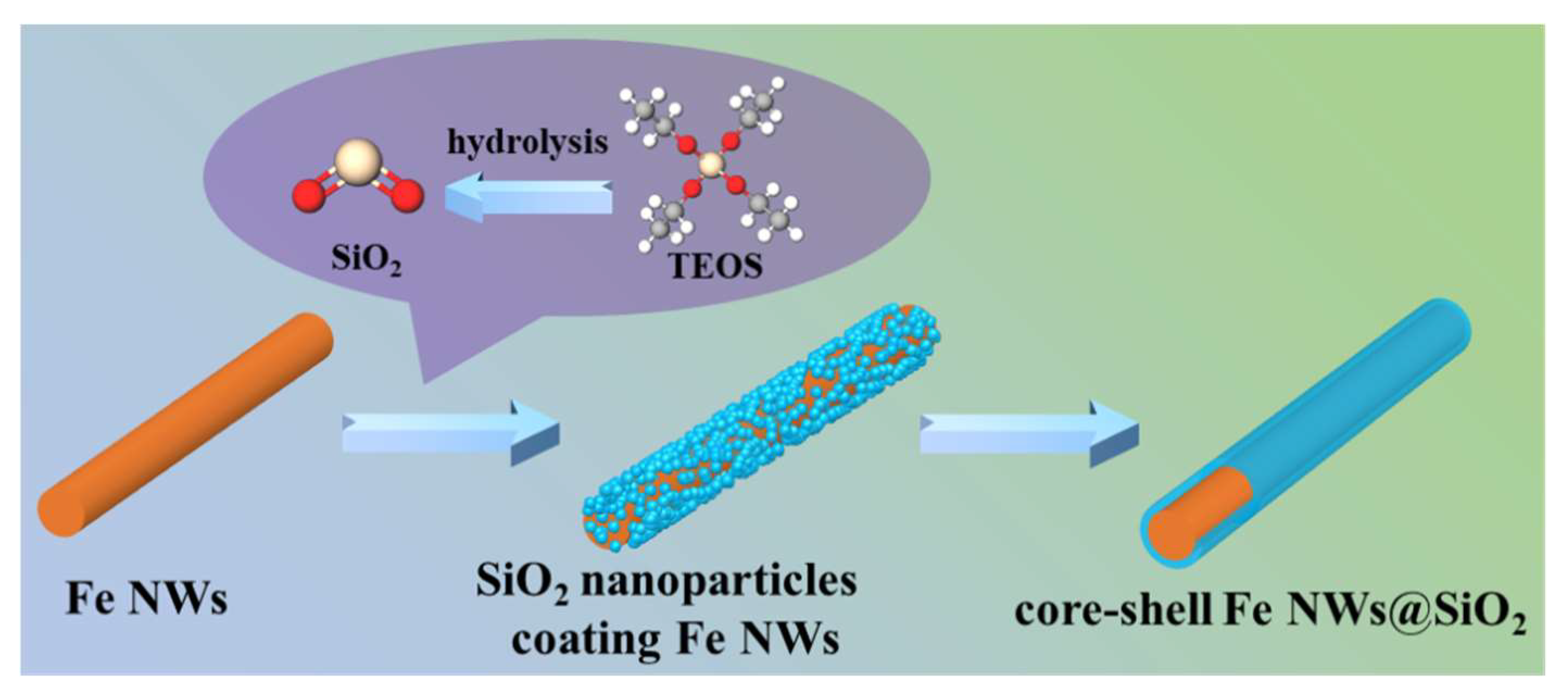
Disclaimer/Publisher’s Note: The statements, opinions and data contained in all publications are solely those of the individual author(s) and contributor(s) and not of MDPI and/or the editor(s). MDPI and/or the editor(s) disclaim responsibility for any injury to people or property resulting from any ideas, methods, instructions or products referred to in the content. |
© 2023 by the authors. Licensee MDPI, Basel, Switzerland. This article is an open access article distributed under the terms and conditions of the Creative Commons Attribution (CC BY) license (https://creativecommons.org/licenses/by/4.0/).
Share and Cite
Yang, P.; Ye, W.; Ruan, H.; Li, R.; Shou, M.; Yin, Y.; Huang, X.; Zhang, Y.; Luo, J. Core–Shell Structured Silica-Coated Iron Nanowires Composites for Enhanced Electromagnetic Wave Absorption Properties. Int. J. Mol. Sci. 2023, 24, 8620. https://doi.org/10.3390/ijms24108620
Yang P, Ye W, Ruan H, Li R, Shou M, Yin Y, Huang X, Zhang Y, Luo J. Core–Shell Structured Silica-Coated Iron Nanowires Composites for Enhanced Electromagnetic Wave Absorption Properties. International Journal of Molecular Sciences. 2023; 24(10):8620. https://doi.org/10.3390/ijms24108620
Chicago/Turabian StyleYang, Pingan, Wenxian Ye, Haibo Ruan, Rui Li, Mengjie Shou, Yichen Yin, Xin Huang, Yuxin Zhang, and Jiufei Luo. 2023. "Core–Shell Structured Silica-Coated Iron Nanowires Composites for Enhanced Electromagnetic Wave Absorption Properties" International Journal of Molecular Sciences 24, no. 10: 8620. https://doi.org/10.3390/ijms24108620
APA StyleYang, P., Ye, W., Ruan, H., Li, R., Shou, M., Yin, Y., Huang, X., Zhang, Y., & Luo, J. (2023). Core–Shell Structured Silica-Coated Iron Nanowires Composites for Enhanced Electromagnetic Wave Absorption Properties. International Journal of Molecular Sciences, 24(10), 8620. https://doi.org/10.3390/ijms24108620





